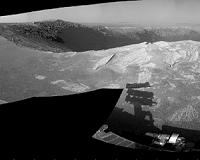 |
Pasadena CA (SPX) Jan 21, 2011 The team operating NASA's Mars rover Opportunity will temporarily suspend commanding for 16 days after the rover's seventh anniversary next week, but the rover will stay busy. For the fourth time since Opportunity landed on Mars on Jan. 25, 2004, Universal Time (Jan. 24, Pacific Time), the planets' orbits will put Mars almost directly behind the sun from Earth's perspective. During the days surrounding such an alignment, called a solar conjunction, the sun can disrupt radio transmissions between Earth and Mars. To avoid the chance of a command being corrupted by the sun and harming a spacecraft, NASA temporarily refrains from sending commands from Earth to Mars spacecraft in orbit and on the surface. This year, the commanding moratorium will be Jan. 27 to Feb. 11 for Opportunity, with similar periods for the Mars Reconnaissance Orbiter and Mars Odyssey orbiter. Downlinks from Mars spacecraft will continue during the conjunction period, though at a much reduced rate. Mars-to-Earth communication does not present risk to spacecraft safety, even if transmissions are corrupted by the sun. NASA's Mars Reconnaissance Orbiter will scale back its observations of Mars during the conjunction period due to reduced capability to download data to Earth and a limit on how much can be stored onboard. Opportunity will continue sending data daily to the Odyssey orbiter for relay to Earth. "Overall, we expect to receive a smaller volume of daily data from Opportunity and none at all during the deepest four days of conjunction," said Alfonso Herrera, a rover mission manager at NASA's Jet Propulsion Laboratory, Pasadena, Calif. The rover team has developed a set of commands to be sent to Opportunity in advance so that the rover can continue science activities during the command moratorium. "The goal is to characterize the materials in an area that shows up with a mineralogical signal, as seen from orbit, that's different from anywhere else Opportunity has been," said JPL's Bruce Banerdt, project scientist for Opportunity and its rover twin, Spirit. The area is at the southeastern edge of a crater called "Santa Maria," which Opportunity approached from the west last month. Drives last week brought Opportunity to the position where it will spend the conjunction period. From that position, the rover's robotic arm can reach an outcrop target called "Luis de Torres." The rover's Moessbauer spectrometer will be placed onto the target for several days during the conjunction to assess the types of minerals present. The instrument uses a small amount of radioactive cobalt-57 to elicit information from the target. With a half-life of less than a year, the cobalt has substantially depleted during Opportunity's seven years on Mars, so readings lasting several days are necessary now to be equivalent to much shorter readings when the mission was newer. Opportunity will also make atmospheric measurements during the conjunction period. After conjunction, it will spend several more days investigating Santa Maria crater before resuming a long-term trek toward Endurance crater, which is about 22 kilometers (14 miles) in diameter and, at its closest edge, about 6 kilometers (4 miles) from Santa Maria. Opportunity's drives to the southeastern edge of Santa Maria brought the total distance driven by the rover during its seventh year on Mars to 7.4 kilometers (4.6 miles), which is more than in any previous year. The rover's total odometry for its seventh anniversary is 26.7 kilometers (16.6 miles). Opportunity and Spirit, which landed three weeks apart, successfully completed their three-month prime missions in April 2004, then began years of bonus extended missions. Both have made important discoveries about wet environments on ancient Mars that may have been favorable for supporting microbial life. Spirit's most recent communication was on March 22, 2010. On the possibility that Spirit may yet awaken from a low-power hibernation status, NASA engineers continue to listen for a signal from that rover.
Share This Article With Planet Earth
Related Links Mars Exploration Rovers Mars News and Information at MarsDaily.com Lunar Dreams and more
 Rover Continues To Explore Santa Maria Crater
Rover Continues To Explore Santa Maria CraterPasadena CA (JPL) Jan 11, 2011 As the New (Earth) Year begins, Opportunity is continuing to explore the 80-meter (262-foot) diameter Santa Maria crater. The exploration campaign consists of wide-baseline imaging surveys with both navigation camera (Navcam) and panoramic camera (Pancam) from several points around the rim of the crater. Because of the holiday period on Earth, the rover performed several sols of remo ... read more |
|
| The content herein, unless otherwise known to be public domain, are Copyright 1995-2010 - SpaceDaily. AFP and UPI Wire Stories are copyright Agence France-Presse and United Press International. ESA Portal Reports are copyright European Space Agency. All NASA sourced material is public domain. Additional copyrights may apply in whole or part to other bona fide parties. Advertising does not imply endorsement,agreement or approval of any opinions, statements or information provided by SpaceDaily on any Web page published or hosted by SpaceDaily. Privacy Statement |